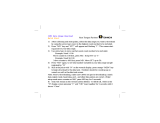
3
Table of Contens
1 Introduction ............................................................................................................................................ 4
1.1 Instructions ...............................................................................................................................................4
1.2 Intended Use ............................................................................................................................................4
1.3 Safety Instructions ....................................................................................................................................4
1.4 Safety Marking ......................................................................................................................................... 5
1.5 Environment .............................................................................................................................................5
2 Technical Data ........................................................................................................................................6
3 Contents of Delivery .............................................................................................................................. 7
4 Control Panel ..........................................................................................................................................8
5 Installation .............................................................................................................................................. 9
5.1 Electrical Links ......................................................................................................................................... 9
5.2 Adjustable Platform ..................................................................................................................................9
5.3 Switch on ................................................................................................................................................10
5.4 Adjustment the distance between Circular and Linear Blade ..................................................................11
5.5 Recommendation for cutting Circular Blade 60 ......................................................................................12
5.6 Recommendation for cutting Circular Blade 125 / 185 (FR4) ................................................................12
5.7 Adjustment the Cut Length .....................................................................................................................13
5.8 Reset the counters .................................................................................................................................13
5.9 Setting the speed of cut .........................................................................................................................14
5.10 Select the cut mode ..............................................................................................................................15
6 Operation .............................................................................................................................................. 16
7 Types of Circular Blades ..................................................................................................................... 17
7.1 Circular Blade
Ø
60 ................................................................................................................................. 17
7.2 Circular Blade
Ø
125 ............................................................................................................................... 17
7.3 Circular Blade
Ø
185 ............................................................................................................................... 18
8 Replacement of the Blades ................................................................................................................. 19
8.1 Circular Blade
Ø
60 ................................................................................................................................. 19
8.2 Circular Blade
Ø
125/185 ........................................................................................................................ 19
8.3 Removal and installation of linear blades ...............................................................................................20
8.4 Aligning the linear blade .........................................................................................................................20
8.5 Change of blade type .............................................................................................................................21
8.6 Alignment of the blade carriage .............................................................................................................21
9 EU Declaration of Conformity .............................................................................................................22























